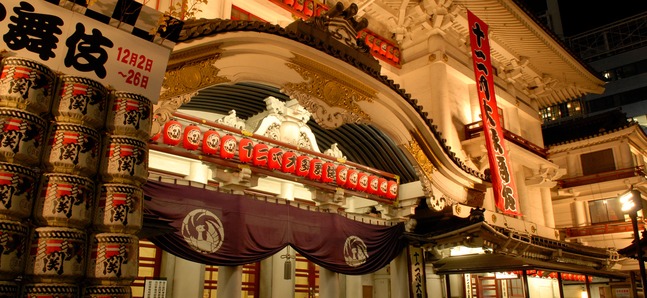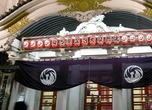
Posted: Mon Sep 28 2009
Fearsome masks, silken costumes, stylised dialogue, intricate choreography and the piquant tones of exotic instruments: these are only a few of the elements that beckon the curious into the mysterious world of traditional Japanese performing arts. Often impenetrable to the outsider, ancient forms such as Noh, bunraku and kabuki employ archaic language and can even be difficult for locals to understand. However, there is much to appreciate on an aesthetic basis alone, and many of the themes – clan battles, servant-master loyalty, revenge and justice, conflicts between duty and loyalty, unrequited love – are universal. Additionally, English programmes and simultaneous translations are increasingly available.
As with other traditional theatre forms throughout Asia, Japanese theatre integrates dance, music and lyrical narrative. In contrast to Western theatre's preoccupation with realism, the emphasis is on beauty, the mythic and the ritualistic. Another distinguishing feature is ma, perhaps best translated as a ‘pregnant pause'. More than just silence, ma is the space that interrupts musical notes or words and is used to intensify the power of the dramatic moment.
The Japanese theatre-going experience is also markedly different from that in the West. Cast aside all notions of hushed reverence and fur coats: a trip to the theatre is a social outing here, and many people come for an afternoon at, say, Ginza's Kabuki-za, armed with flasks of hot drinks, packed meals and bags full of goodies, which are noisily chomped throughout the performance. Spectators often comment on the action as it happens, for example calling out the stage name of the performer at significant moments. A particularly fine tableau may well elicit a burst of spontaneous applause.
BUNRAKU
While puppetry in Japan goes back at least to the 11th century, modern bunraku takes its name from the Bunraku-za organised in Osaka in the early nineteenth century, and was developed by city-dwelling commoners of the Edo period (1600-1868). The puppets used in bunraku are a half to two-thirds human size and require great skill and strength to operate. Each puppet is operated by two assistants and one chief puppeteer. Becoming a master puppeteer is a lengthy process, beginning with ten years spent operating the legs, followed by another ten on the left arm before being permitted to manipulate the right arm, head and eyebrows.
Four main elements comprise a bunraku performance: the puppets themselves; the movements they make; the vocal delivery of the tayu, who chants the narrative and speaks the lines for every character, changing his voice to suit the role; and the solo accompaniment by the three-stringed, lute-like shamisen.
KABUKI
Kabuki is said to have originated with Okuni, a female attendant at the Izumo shrine in Kyoto, who first led her mostly female company in performances on the dry bed of the Kamogawa river in 1603. Kabuki means ‘unusual' or ‘shocking', and it quickly became the most popular form of theatre in seventeenth- and eighteenth-century Japan. However, concerns over the sexual antics of the entertainers, on and off stage, meant that women performers were banned in 1629; now all kabuki actors are male. Women's parts are taken by onnagata (specialists in female roles), who portray a stylised feminine beauty. There is no pretence of realism, so the actor's real age is irrelevant – there is no incongruity in a 75-year-old man portraying an 18-year-old maiden.
Of all the traditional performing arts in Japan, kabuki is probably the most exciting. The actor is the most important element in kabuki, and everything that happens on stage is a vehicle for displaying his prowess. Koken, stage hands dressed in black, symbolising their supposed invisibility, hand the actor props, make running adjustments to his heavy costume and wig, and bring him a stool to perch on during long speeches or periods of inactivity.
Most kabuki programmes feature one shosagoto dance piece, one jidaimono and one sewamono. Jidaimono are dramas set in pre-Edo Japan. They feature gorgeous costumes and colourful make-up called kumadori, which is painted along the lines of the actor's face. The actor uses melodramatic elocution, but because jidaimono originated in the puppet theatre, the plays also feature accompaniments from a chanter who relates the storyline and emotions of the character, while the actor expresses them in movement, facial expressions or poses. Sewamono are stories of everyday life during the Edo period and are closer in style to Western drama.
Every kabuki theatre features a hanamichi, an elevated pathway for the performers that runs through the audience from the main stage to the back of the theatre. This is used for entrances and exits, and contains a trap door through which supernatural characters emerge.
NOH AND KYOGEN
Japan's oldest professional theatre form, Noh, dates back to fourteenth century Shinto and Buddhist religious festivals and was used both to educate and entertain. The ritualistic nature of Noh plays is emphasised by the masks worn by the principal character. Plays are grouped into categories, which can be likened to five courses of a formal meal, each with a different flavour. Invigorating celebratory dances about gods are followed by battle plays of warrior-ghosts; next are lyrical pieces about women, then themes of insanity, and finally demons. Presentation is mostly sombre, slow and deliberate. Plays explore the transience of this world, the sin of killing and the spiritual comfort to be found in Buddhism.
There are no group rehearsals: there is a pre-performance meeting, but the actors and musicians do not play together until the performance. This spontaneity is one of the appeals of this kind of theatre.
Kyogen are short, humorous interludes that show the foolishness of human nature through understated portrayal. They are interspersed for comic relief with Noh pieces, but are intended to produce refined laughter, not boisterous humour.
- Cerulean Tower Noh Theatre
- Address: Cerulean Tower Tokyu Hotel B2F, 26-1 Sakuragaokacho, Shibuya-ku
- Telephone: (03)5728 0168
- Website: www.ceruleantower.com
- Housed in the basement of the Cerulean Tower hotel, this is the city’s newest venue for Japanese theatre. It hosts both professional and amateur Noh and kyogen performances – without English translation.
- Kabuki-za
- Address: 4-12-15 Ginza, Chuo-ku
- Telephone: (03)3541 3131
- Website: www.shochiku.co.jp/play/kabukiza/theater/
- Japan's number-one kabuki theatre. The schedule changes monthly, with matinées starting around 11am and evening performances around 4.30pm. Shows can last up to five hours, including intervals. You can also buy tickets to watch just one act from the fourth floor; these go on sale from one hour beforehand and often sell out. An English-language programme (¥1,000) and audio guide (¥650, plus a refundable deposit of ¥1,000) are invaluable. Note that the restaurants and souvenir shop are not accessible to fourth-floor visitors. Get to the Kabuki-sa while it’s still around. The theatre’s traditional building has been slated for a controversial demolition and complete, modern makeover. Farewell performances are scheduled from January to April 2010, and the new theatre will open on a new site in 2013.
- National Noh Theatre
- Address: 4-18-1 Sendagaya, Shibuya-ku
- Telephone: (03)3230 3000
- Website: www.ntj.jac.go.jp/english/
- Noh performances are normally staged here four or five times a month. A one-page explanation of the story in English is available.
- National Theatre
- Address: 4-1 Hayabusacho, Chiyoda-ku
- Telephone: (03)3230 3000
- Website: www.ntj.jac.go.jp/english/
- Kabuki is staged seven months a year in the National Theatre's Large Hall, while bunraku is staged in the Small Hall four months a year. Programmes include the story in English, and English audio guides are available (¥650, plus a refundable ¥1,000 deposit).
Time Out Tokyo Guide (5th edition published in 2007)
Tweets
- About Us |
- Work for Time Out |
- Send us info |
- Advertising |
- Mobile edition |
- Terms & Conditions |
- Privacy policy |
- Contact Us
Copyright © 2014 Time Out Tokyo











Add your comment